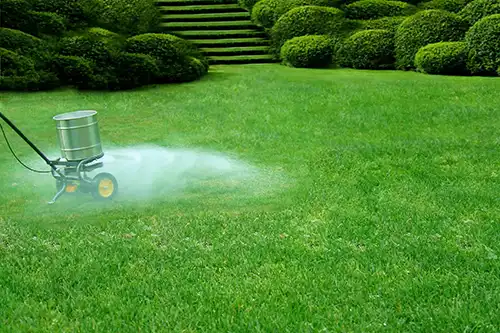While most granular fertilizers dissolve within 1 to 2 days, the exact time can vary depending on the brand and formula. Be sure to consult the packaging for proper application guidance and mowing instructions. Additionally, factors such as temperature and moisture levels can also influence the dissolution time.

Why Do Some Fertilizers Take Longer to Break Down?
Some granular fertilizers feature coatings that slow down the release of nutrients, known as controlled or slow-release formulas. These fertilizers can sustain your lawn’s nutrient needs over weeks or even months, based on their specific design.
Granular fertilizer’s dissolution rate is influenced by environmental elements like temperature and moisture. Warmer temperatures and damp soil can accelerate the process, while cooler and drier conditions can slow down nutrient release. Be mindful of these factors when applying fertilizer to ensure optimal nutrient absorption for your lawn.
What Should I Do If My Granular Fertilizer Isn’t Dissolving?
If you notice granular fertilizer remaining on your lawn a few days after application, it may require additional water to fully dissolve. The granules dissolve with rain or irrigation, releasing nutrients for your grass. Increase watering depth or frequency to help break them down.
If you’ve been watering more but aren’t seeing improvements, reaching out to a lawn care professional may be helpful. They can assess your lawn and advise on the best approach to nourish your grass. Additionally, they may identify other factors, such as soil health or pest issues, that could be affecting your lawn’s condition.
Need Lawn Care? We Can Help.
Click the button below to leave your information & we'll be in touch in an hour or less.
Need Pest Control Service?
Leave your information below and we’ll be in touch with a FREE quote!
"*" indicates required fields
*During normal business hours. After hours calls will be returned the next business day.
How Long Does It Take Fertilizer to Work?
Most fertilizers begin to show effects within one to five days after being absorbed by your lawn. Slow-release varieties may take longer, but improvements are usually noticeable within two weeks. If you don’t see any changes after two weeks or notice issues like uneven growth, you may be dealing with one of these problems:
- Thatch Buildup or Soil Compaction: Thatch is a layer of decaying organic material, such as twigs and leaves, that naturally forms on lawns. Buildup occurs when it doesn’t break down properly, and compaction happens when the soil becomes too dense, restricting the movement of water and air. Both problems prevent fertilizer from reaching the grassroots.
- Incorrect Fertilizer Formula: Different lawns have unique needs based on factors like grass type, sunlight exposure, and soil conditions. With so many fertilizer options available, it’s easy to choose one that doesn’t align with your lawn’s specific requirements.
- Cold, Dry, or Wet Weather: Excessive rain can wash away fertilizer shortly after application, leaving nutrients unavailable for your lawn. On the other hand, in dry conditions, the fertilizer may not penetrate the soil. Additionally, applying fertilizer during cold weather or just before a freeze is ineffective, as your grass is likely dormant and unable to absorb the nutrients.
It’s frustrating to apply fertilizer and not see the results you were hoping for, especially when the cause isn’t obvious. If you’re encountering issues and want better outcomes, a lawn care professional can help. They’ll evaluate your lawn’s overall condition and provide guidance on optimizing your fertilization routine.
